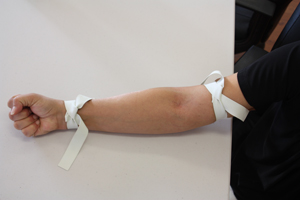From the Editor's Desk
by Dennis Ernst • January 09, 2020

Do you know someone who has introduced you to a new twist to your blood collection technique? Have you devised one yourself? If you're one of the many who have made modifications to the standardized procedure without approval or justification, you may be putting your patient and employer at risk.
Let's face it. Drawing blood is a standardized procedure. It is based on intense literature research and maintained by a highly respected authoritative body, the Clinical and Laboratory Standards Institute. Every five years, the organization assembles a group of experts in the field from a wide variety of backgrounds to review and revise the standards for drawing blood by skin puncture and venipuncture (among dozens of other laboratory processes).
Calling upon their collective expertise and the published body of knowledge, the working group spends thousands of hours collectively researching, perfecting and updating the standards to reflect the prevailing literature and current thinking. After a standard is revised by the working group, it undergoes intense scrutiny by peer reviewers who work daily in one clinical laboratory capacity or another. Their comments are considered and the standard is further revised. Upon publication, laboratories around the world obtain the document and update their own procedure manuals to reflect the new standard.
When frontline healthcare professionals take it upon themselves to "improve" this highly refined and well established technique with their own homespun modification, they are thumbing their nose at the expertise of literally hundreds of authorities.
When a departure from the standardized procedure results in injury, or alters test results to a degree that impacts how patients are treated, diagnosed, medicated, and managed, patients suffer and employers can be held accountable for the consequences. So I need to implore you to ask yourself this question: Are my creative blood collection practices placing patients and my employer in jeopardy?
In my latest book, The Lab Draw Answer Book, I devote an entire chapter on "unorthodox techniques" It discusses 15 quirky, homespun ideas I've heard about that have worked themselves into practice in the real world.

There's some real doozies in this chapter, such as:
- Inserting the needle with the bevel down---This makes no sense. Don't try it. The standards say "bevel up." End of discussion.
- Letting blood drip from an arterial line into the tube---This makes the heads of most infection control nurses explode, and it should. Why risk almost certain blood exposure by employing this technique when a syringe will keep the collection system closed? Oh, because you wear gloves and you won't be exposed if blood drips onto your hands? Not so fast. The HIV virus can pass through the micropores of most gloves.
- Double tourniquet technique---Some confused trainers actually teach their students to tighten one tourniquet above the antecubital area and another one around the wrist. This begs the question: why would constricting the blood below the antecubital do anything but minimize the blood in the veins above it? Knowledge is power; a little knowledge is dangerous.
- "Harvard" stick---This technique, obviously created in the dark, portends that if you hold a patient's arm a certain way, then insert the needle in a precise location in the antecubital area, you'll get the vein every time. Mind you it's never been studied, reported, or appeared in any reputable publication. That alone makes it spooky enough for me to put in the book.
- Reopening a skin puncture site for more blood---Believe it or not, someone actually thinks a previously punctured fingerstick or heelstick site can be physically reopened with an alcohol prep to collect more blood instead of using a lancet on another location. This constitutes evidence that not everyone should be allowed to draw blood.
- Smearing petroleum jelly on skin puncture sites---it has been concocted by someone with unbridled creativity that smearing a petroleum jelly product like Vaseline on the patient's skin prior to the puncture prevents a messy collection. Never mind that the petroleum jelly could contribute to an inaccurate test result. Somebody go get the bridle.
- Bending the needle---On more than one occasion, I've heard of physicians teaching their staff to bend the needle prior to inserting it into the vein to decrease the angle of insertion. Sounds a little "kinky" to us.
- Using a tourniquet to apply pressure---If you're looking for evidence that humans are incredibly creative, look no further. This practice was brought to my attention as one facility's permitted substitute for applying pressure to the puncture site whenever the patient cannot assist. The tourniquet is tightened around the arm to hold the gauze in place until the collector can tend to the wound. Perhaps it's time tourniquets come with instructions on how not to use them.
- Pouring off blood from one tube to another---Phlebotomy Today readers know better, but not every healthcare worker subscribes yet. Therefore, let it be written and handed down from generation to generation: tubes with additives cannot be combined, even if they have the same color stopper. Some argue that the contents of clot activator tubes can be combined with that of another clot activator tube, but do you really want to go down this slippery slope? All it takes is for someone to be seen pouring the contents of one tube into another, and the assumption is made that it's acceptable for all tubes. Don't go there.
Even if you're convinced one or more of these techniques is a harmless improvement on the traditional method, you'll be hard-pressed to justify your modification to a jury should an injury or medical error occur. Rest assured, should you be involved in a legal case in which your technique is called into question, any deviation from the standard is likely to be exploited by the patient's attorney... even if it's not pertinent to the case. Being caught with one foot out-of-bounds is an irresistible invitation to cast you as a renegade who spends most of her time there. Give 'em an inch, and they'll take whatever the jury awards.
Here's a New Year resolution everyone should adopt: stick to the standards... literally and figuratively. Trust me, you do NOT want me reviewing a case in which you created your own unique twist to a well-established industry standard. I love my readers, make no mistake. But the only needles you should be creative with involve knitting.
Related Posts and Information
overall rating: my rating: log in to rate
deviations YouTube technique unorthodox
